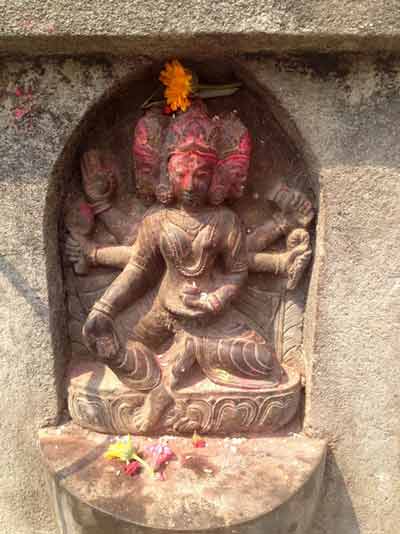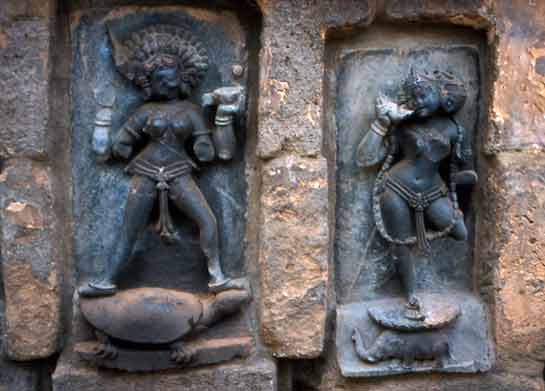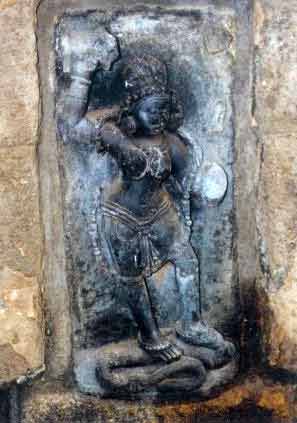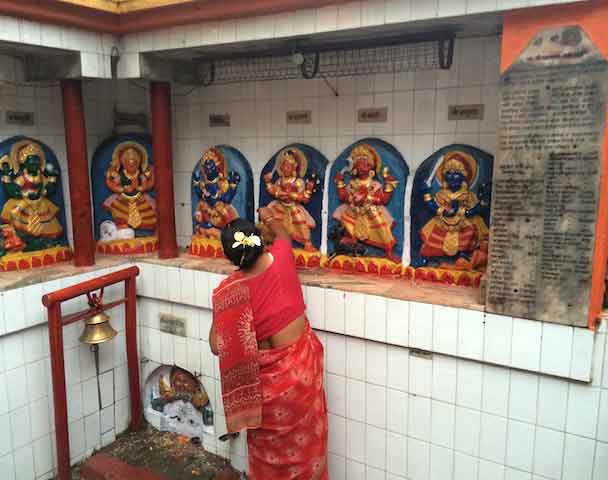Chausath Yogini temple (Mahamaya temple) dedicated to 64 Yoginis By Soumendra Barik
In South Asia, Goddess is described as “the one and the many.” She appears as Devi, the Great Shining One in Her infinite manifestations and as collectives of numerous goddesses. Collectives of female deities have a long-standing place in South Asian history, mythology, legend and the natural landscape. Many of these goddesses have elemental energies, others contain certain powers of the natural world, and still others emulate the powers of the female body and sexual and reproductive cycles as well as stages within a woman’s life. In previous essays for Sutra Journal I have written about one of Devi’s collectives, the Asta Matrikas, eight forms of the Goddess Durga, who have both elemental and protective natures. There are other collectives of Durga: the Nava (nine) Durgas and the 42, 64, and 81 Yoginis. Sometimes Durga is even referred to as the “Queen of the Yoginis.” An entire spiritual tradition within various non-dual Tantric lineages (Naths, Siddhas, Kapalikas, Kaulas, et.al) has been formed around these groups of Yoginis and many of them include the Asta Matrikas and Nava Durgas in their fold. These goddesses have individual and collective powers and together they also represent aspects of Devi. In this essay I present different categories of Yoginis and discuss the significance of their unique temples. I also look at the contemporary Yogini as an alternative path for female practitioners.
 Brahmani Matrika. Laura Amazzone.
Brahmani Matrika. Laura Amazzone.
The Yogini
Since ancient times, the Yoginis have appeared in various forms and often have a close association with nature. In fact, many of the qualities of the Yoginis can be found with the Yakshis and Yakshinis, the tree and nature spirits of early Buddhism and Hinduism. Like the Yakshis, the Yoginis are said to be lavishly adorned, have captivating appearances that can be both terrifying and mesmerizing, and offer “life-enhancing energies that bring about fertility, growth, longevity, abundance and material and spiritual well-being.”[i] The Yakshi and Yoginis appear both as accomplished female practitioners and in more “supernatural” or esoteric forms. Yakshis also share similar protective functions as guardians of space and the directions with the Matrikas. The 64 and 81 Yogini circles we find in both the medieval temple iconography as well as lists in Tantric and Puranic texts[ii] comprise of groups of goddesses based on multiples of the number eight and nine. It seems that both groups, the Sapta (seven) or Asta (eight) Matrikas and the Nava (nine) Durgas, who each have a different plant or tree associated with them and share powers around fertility with the Yakshis, later evolved into the collectives of 64 and 81 Yoginis that are known today.
In one of the only and most comprehensive English works on the Yogini, Yogini Cult and Temples, Vidya Dehejia describes the various categories or definitions of the Yogini. The Yogini is Goddess Herself as well as practitioner, devotee and attendant of Goddess. As we see from the varied listings in Tantric and Puranic texts as well as the multifold depictions of them in the temple iconography, Yoginis cannot be pinned to one particular quality, rather, their natures are fluid. They express the full-embodied expression of human experience. Yoginis are wrathful and sensual, ferocious and seductive, furious and graceful. They hold all sorts of tools and weapons, symbolic of what the initiated practitioner needs on their path—a knife to sever attachments, a goad to nudge us along when we are stuck, a bell to clear negativity, a spear for penetrating insight, a bow and arrow for focus, etc. Their mounts are animals, vegetation, and different potent symbols such as a pot, flames, corpse, or drum that lend their powers and mythological significance to the Yoginis. Perhaps the Yoginis’ attributes, names, and iconography have been modeled after living women practitioners from the different lineages in which they were worshiped.
The Yogini is sometimes perceived as a sorceress or a witch. Legends tell of her abilities to turn humans into animals. Several such stories speak of a magic thread that is tied around the Yogini’s lover’s neck. He is then turned into a parrot or monkey and is forced to remain in that form until she sexually desires him and breaks the spell to make love to his human form.[iii] Other tales tell of flying women (Dakinis) or women who suddenly vanish in the night. This category of Yoginis always meets in circles to perform their rituals, which include transgressive acts that are said to give them supernatural powers.
There are also eight Yoginis of astrology: Mangala, Pingala, Dhanya, Brahmari, Bhadrika, Ulaka, Siddhida, and Sankata. Each is associated with one of the nine grahas, or planets. At a human’s birth, the stellar positions of these Yogini-governed planets give specific details about the fate of the individual. Consulting the position of these stellar Yoginis before a pilgrimage or any serious undertaking was common practice in the past and texts outline prayers, rituals and ways to appease and invoke the protection of these esoteric Yoginis.[iv]
Another grouping of Yoginis resides in our chakras. Their names are: Dakini, Rakini, Lakini, Kakini, Sakini, Hakini, and Yakini. Each of the seven chakras is presided over by one of these Yoginis. They work with the subtle energies that travel through the ida, pingala, and ṣushumna channels. They are involved in an energetic process of awakening kundalini (the creative and sexual Goddess energy that lies dormant at the base of the spine) and inviting this energy to travel up our spines to the crown of our heads, where She unites with the Divine energy that is described as Shiva in many of the Tantric texts.[v]
Scholar Stella Dupuis has spent years doing field research on the various Yogini temples, writing books and a Yogini oracle, and translating one of the key Tantric texts of the Yogini cult, the Kaulajnananirnaya Tantra.[vi] Dupuis and other scholars attribute the origins of one of the most known Yogini lineages (Yogini Kaula) to the Great Yogi and Sage, Matsyendranath of the 10th century. According to legend Matsyendranath overheard the esoteric teachings on the mysteries of the Universe through a conversation between Shiva and Parvati from the belly of a fish. He composed the Kaulajnananirnaya Tantra and became well-known in Tantric circles through the famous philosopher and Tantric scholar, Abhinavagupta, who gave him the title, “The Father of Yoga.” While Matsyendranath is a key figure in understanding the teachings and significance of the Yogini circles on the Kaula path, it is important to acknowledge the many different lineages (Siddhas, Naths, Kaula, Kapalika, Sri Vidya, etc.) in which both non-embodied and embodied Yoginis are central to the practices. The varied lineages that honor these groupings of Goddesses point to the pre-orthodox, tribal, and indigenous practices of the forest peoples on the South Asian subcontinent.
 Normada and Jamuna Yoginis Hirapur. Laura Amazzone.
Normada and Jamuna Yoginis Hirapur. Laura Amazzone.
The Yogini Temples
According to Dehejia and Dupuis, there are only about fourteen known temples to the Yoginis throughout South Asia; however, there are other sites where worship of the Yogini is still practiced. “The Kamakhya temple in Assam is one of the few Devi shrines where to this day, the daily worship of Devi Kamakhya includes the invocation of the 64 Yoginis.”[vii] Kamakhya is the site where the Goddess’ yoni fell according to myth, and it is considered the most sacred of temples. Practices including Yoginis as well as participation by living Yoginis still exist, suggesting at least 1200 years of continuous Yogini worship. In fact, Kamakhya is known to be one of the most potent pilgrimage sites for Yoginis and Yogis of the Shakta tradition. Given the Yoginis’ unconventional status and the esoteric and often culturally offensive practices that have been associated with the Yoginis, one can assume that there are other sites where Yoginis are and have been worshiped, which have been kept secret from the uninitiated.
Temples to the Yoginis in India were built between the ninth and sixteenth centuries and their worship seems to have flourished amongst the royalty during that time. “Royalty was closely connected with the Yogini cult.”[viii]Rites were performed to gain territory, subdue one’s enemies, expand dynasties, and for all militaristic adventures. These Goddesses were believed to bring fame and invincibility, strength and courage. While it may seem contradictory to associate these female deities with militaristic and worldly pursuits, I am reminded of the non-dual Tantric understanding of the impartiality and ultimate neutrality of the Divine. Rituals are performed that these deities fulfill without the ethical or moral associations we in the human realm have. In addition, the Yoginis have always been associated with all rites of sexual pleasure and love. If we look to the pre-orthodox traditions all over the ancient world, we find evidence of Goddess-centered cultures that celebrated sexuality and creativity for millennia. However, in South Asia, in the 2nd CE when the Laws of Manu came into effect, women were stripped of their right to own property, patrilineality over matrilineality became the “norm,” widowhood essentially became a death sentence, and women were made into submissive objects rather than equal subjects within domestic marriage. Women like some of the fiercely sensual and independent indigenous Goddesses were “spousified and domesticated.”[ix] Contrary to social and domestic expectations around women in South Asia, the Yoginis’ temples and rituals seem to be one domain where the human female has power, agency, autonomy and especially choicearound her sexuality. Worshiping the Yoginis in human form has always been important to the rituals. Music, dance, sexuality and the arts are the Yoginis’ domain.
All of the known Yogini temples are circular, except for two, which are rectangular. One common characteristic between all Yogini temples is that they are hypaethral or without a roof. Perhaps the Yogini temples are open to the sky to allow for the nightly ecstatic flights that the lore around the Yogini cults described. Perhaps these women were divine beings who did fly, or perhaps they flew astrally; either through shifting their consciousness with tantric visualization practices, or through the use of sacred substances. Regardless, the openness of the temples allows for the expansion of energies and a merging of earthly energies with the cosmic energies of the sky. The circular form of the temples denotes the demarcation of sacred space.
Using circles has long been a means to separate mundane from sublime realms. Perhaps the aniconic forms of the Matrikas in the Kathmandu Valley, usually expressed in a full or semicircle could have been an earlier natural form that developed into the hypaethral circular temples of the Yoginis we find today. Circles are known to be magically protected areas where energy is raised and does not dissipate. A circle symbolizes the sun, moon, eye, the zodiac, time, eternity, nothing and all. It is a shape that “expresses most effectively the complementary concepts of completeness and separateness: complete in itself and separated from everything outside of it. It is a symbol of the self as a self-contained whole.”[x] Eight Matrika shrines encircle the city of Bhaktapur in the Kathmandu Valley. The function of the Matrikas, who are often included in the folds of the Yoginis, is to guard the space within the circle. The space within a city, village, Yogini circle, or circular temple is a place where secret rites also must be protected.
In all the Yogini temples, temple niches line the inner temple walls and are inhabited by Yoginis in various postures and bhavas (moods or expressions of the divinity). They all bear witness to the central altar, which sometimes is inhabited by a fierce form of Shiva. However, the main and central deity of the temple is a form of the Great Goddess Durga in Her Mahisuramardini aspect or as Mahamaya. In one of the temples, Lokari, all the Yoginis have animal heads and female bodies,[xi] while in another, Rihikyan, they are all in the dancing pose. [xii] In all of the temples, each of the Yoginis has either an animal, vegetation, or some potent symbol for a mount or vehicle. Some have a very commanding and formidable appearance; others are quite seductive, sensual and express an explicit sexual energy; and still others exude an aura of self-possession, mystery, fulfillment and contentment. Wrathful and terrifying Yoginis are also included in these circles. The different appearances of the Yoginis also speak to the ways their energies work with the practitioners. For example, often the more wrathful and fierce the Yogini appears, the more direct that Yogini’s impact on the conditioned and limited mind of the practitioner.
 Serpent Yogini. Laura Amazzone.
Serpent Yogini. Laura Amazzone.
Yogini as a Practitioner
When we consider the Yogini as a human practitioner we see a path of unconventionality. It is important to acknowledge that not every woman is a Yogini. Even if she is a practitioner of Yoga asana, she may not necessarily be a Yogini as the definition extends beyond the limited presentation of Yoga we often find outside of South Asia. Yoginis of past and present are women who embody a spiritual, social and cultural status that is outside the consensus patriarchal culture. Yoginis are “women who dare to define themselves in relation to the metaphysical rather than the social.” [xiii] Within the Tantric tradition, there are many different schools and lineages that inform the Yoginis path. On the non-dual path, some of the Yogini streams such as the Naths, Kaula, Kapalika, Siddha, Trika, et.al offer practices that encourage us to live outside societal stereotypes and conventions, stripping away limiting or socially conditioned identities. In fact, on the non-dual Tantric path, the goal is for limitations, frustrations, and expectations to drop away so that one can experience a sense of dissolution and expansion into Oneness. Most important to the practices is liberation in the body that will take one’s consciousness through the gates of death and into the next levels of Reality. However, achieving spiritual liberation requires transforming mental and emotional barriers.
Amarananda Bhairavan notes,
For spiritual freedom, a person needs to break away from this
mechanical working of symbols, values, and labels
into which awareness is fragmented and driven through life. . . .
Liquidating these knots releases the energy of awareness bound in them.
Collecting this awareness and rerouting it into your Self
is the key to this freedom.
When all these labels and tags are removed,
the world of phenomena will not impose its perception on you anymore.[xiv]
Put simply, the Yoginis’ rites focus on achieving union with the Divine within. They involve practices that embrace and take one beyond the paradoxes of life into a state of bodily bliss and clear awareness. Contrary to the emphasis many spiritual circles place on kundalini rising, a Yogini knows how to work with both the ascent and descent of kundalini (the sexual, creative energy that lies dormant at the base of the spine until awakened). My Yogini teacher within the Sri Vidya tradition emphasizes that within this lineage, one does not attempt to wake up kundalini (who we understand as a sleeping Goddess), but that we make the environment inviting to Her so that She will want to awaken and make Her ascent to our Sahasrara chakra where She merges with Shiva and then descends back to the muladhara, and again ascends up into the heart.
Living Yoginis have a mysterious and alluring élan and with time, dedication and devotion develop a mastery and depth of understanding of both the physical and subtle bodies and realms. To a Yogini on a non-dual path, Goddess is understood as a field of Consciousness. Again we return to Devi as the one and the many. She appears in many forms, some She conceals, others She reveals, and yet all Her infinite forms are ultimately different aspects, moods or fields of Her cosmic and earthly magnificence. Doing sadhana (practice) allows us to harness the energies and qualities of particular deities to achieve different purposes. There are rituals for all rites of passage within both the female and male practitioner’s life. There are rituals and sadhanas for all rites of passage, transitions, and liminal states such as birth, menstruation, sex, illness and death as well as to gain worldly and spiritual powers.
Today sex has become the focus for many who are not on a classical and authentic non-dual Tantric path. While sexual sadhana is referenced in many of the Tantric texts and temple iconography, it is not the ultimate goal. In fact, years of sadhana preparing the subtle and physical bodies are essential for a true practitioner to achieve the fruits of liberation that this non-dual path offers. Yogini and other collective Goddess rituals express and celebrate a different and inclusive perspective of the universe—one of unity in diversity and one that honors and celebrates the powers of the female body and consciousness. Various yogic and tantric practices can help practitioners in accessing higher realms of awareness or fields of Consciousness that are the many expressions of Goddess. We can consider each of the various 64, and 81 Yoginis as aspects of Devi’s Reality that are essential to our existence and ultimate liberation.
Yoginis of past and present have much to offer our understanding of our relationship to Devi within and without. Understanding the many functions and appearances of the Yoginis in both embodied and non-embodied forms presents alternative paths outside the status quo that celebrate the body, the emotions, and the senses. From the Yogini mysteries, we learn there is much more than this physical reality. Any encounter with the Yoginis presents us with the opportunity to question what has been defined as “real” as well as to question what the status quo considers valuable and meaningful. Working with the Yoginis and understanding their place in religion, spirituality and history offer us numerous ways to co-participate in the mysterious cycles of existence.
They teach us the value of both the subtle and physical realms, of the seen and unseen, of waking, dreaming and infinite other possible states and expressions of Consciousness. As some of the Tantric texts and transmitted lineage-based teachings share, working with the different powers of the Yoginis through meditation, mantra, and visualization can help us move through and transform our fears, doubts and any sense of separation we feel. We can discover the powers of the Yogini as powers available within our bodies. We can look to the many tools the Yoginis’ hold in the temple iconography as symbolic aids in dealing with our afflicted egos and conditioned minds. We can embrace the diverse expressions of the Yoginis and honor and celebrate the differences in our own communities. Like the Yoginis of the medieval temples and texts, we can have our own epithets that reflect our unique choices and divine self-expression while still feeling and nurturing a sense of connection and unity with others— despite our differences. The Yoginis and other collectives of Goddesses present alternative models of being on a spiritual path that celebrates our spiritual authority and independence. To me these circles of Yoginis of past and present are repositories of spiritual knowledge, wisdom and practice that can lead us to the ultimate aim of liberation in the body and realizing our own divine natures.
 Worshipping Matrikas. Laura Amazzone.
Worshipping Matrikas. Laura Amazzone.